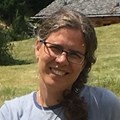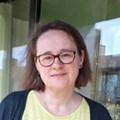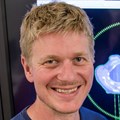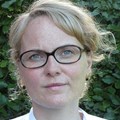Image guided and adaptive radiotherapy
In order to utilize that normal tissue has a better ability to repair radiotherapy (RT) induced damage compared to tumor tissue, the traditional RT schedule is many small, daily treatment fractions (F). During the many treatment F as well as during a single treatment F, the normal tissue and tumor may move differently relative to each other and the RT dose. In order to take this movement into account and ensure adequate dose coverage of the tumor at each F, a safety margin is added. This safety margin will, on the other hand, cost additional increased dose to normal tissue, and increase the risk of normal tissue complication. By receiving daily information on the patient’s anatomy the precision of the treatment can be increased, and the dose to normal tissues can be limited. In order to do so, images can be recorded before and during the delivery of RT. This information can be used to adjust the treatment continuously in relation to the movement of the organs. The principle is called adaptive RT. This project supports a national implementation of adaptive RT so that all Danish patients can access RT with the latest principles of adaptation.

Projects (A-K)
Intra-fractional changes and Deep Inspiration Breathhold (DIBH)
A: DIBH and gating for conventional linac and protons for lung and oesophageal cancer
Aim: Introduction of DIBH or gating during free-breathing (FB) for lung and oesophageal cancer pts who benefit in terms of reduced normal tissue doses. The introduction of DIBH requires a reproducible and stable target position during DIBH.
Identification of patients who benefit: For lung cancer, data exist confirming the benefit of in terms of reduced normal tissue doses, for oesophageal cancer a comparison between dose planning on DIBH and FB will be made.
Evaluation of DIBH/gating stability: Marker-based kV and MV imaging will be performed during the delivery of each field. The stability of DIBH and gating will be evaluated from the stability of markers during the treatment of the single fields. Triggers will be developed for pts with unstable breathing for photons and protons. Stability of DIBH, exhale and inhale gating will be compared. Datasets ready for analysis exists for FB for both lung and oesophageal cancer. For DIBH, a data set is being acquired for lung cancer, while DIBH for oesophageal cancer is expected to start in late 2018.
Participants: Collaboration with other RT centers through DOLG and DECV
B: Intra-fractional stability during DIBH for lung cancer.
Aim: Repeated MR imaging during treatment in deep inspiration breath-hold (DIBH) will be exploited to evaluate patient compliance with direct feedback of the tumor position and to evaluate intra-fractional and hence inter- and intra-DIBH stability of tumor position.
MR linac is offering new means of intra-fractional motion management, using the actual position of the tumor for visual feedback of the DIBH position. MR imaging during treatment enables evaluation of the intra-DIBH stability, without marker implantation or additional burden of imaging dose.
Both pts with locally advanced NSCLC and pts treated with SBRT for early-stage lung cancer or metastases in the lungs will be included.
Deliverables: Intra-fractional uncertainties will be evaluated to be incorporated in margins for treatment on a non-MR linac.
Triggers will be developed for interventions in patients with unstable DIBH.
Guidelines for DIBH treatment on MR linac will be established and could be disseminated to other pts (esophagus, pediatric and liver).
The findings of the study will support DIBH treatment on MR linac, regular linacs, and proton RT, since the evaluated uncertainties could be added to the PTV margins. All centers will benefit from intervention strategies with DIBH.
Participants: RH and HGH
C) Motion-including dose reconstruction
Reconstruction of the dose delivered to a moving tumor in a dynamic treatment (e.g. VMAT) can serve as an important QA tool and improve the accuracy of reported delivered doses. Two approaches for motion-including dose reconstruction are being developed: (1) Post-treatment dose reconstruction in a treatment planning system by multiple isocenter shifts, and (2) intra-treatment real-time dose reconstruction with an in-house developed software program.
Participants: Provided by AU and can be shared with other centers.
3.2 Inter-fractional changes thorax and pelvis
D) Triggers for ART in thorax photon and proton therapy
Aim: To identify and validate triggers for ART for both photons and protons.
Description: For lung photon therapy the triggers exist and have been validated in a large patient cohort. For lung, proton therapy triggers are being identified but has not been validated. For oesophageal cancer, identification and validation of triggers are needed for both photons and protons. The identification will be based on large patient sets with daily CBCT and sub-sets with surveillance 4D-CT during the RT-course. The evaluation method used for the CBCTs depends on the progress in project 3.3.
Participants: AU, OUH
E) Adaptive RT in photon, proton, and brachytherapy of cervix cancer
Background and aim: Inter-fraction pelvic organ motion remains challenging in cervical cancer. This project aims to validate an individualized ITV concept based on repeated imaging at the time of treatment planning and to investigate margin strategies and triggers for adaptation in proton therapy. Method: An image-guided adaptive EBRT strategy based on daily cone-beam CT (CBCT) monitoring, re-planning and patient feedback has been developed at AU, RH, and OUH. The adaptive strategies will be further developed to include the relevance/importance of monitoring of the para-aortic lymph node target). Different margin strategies, robust treatment optimization strategies as well as needs for plan selection will be investigated and minimum standards for a national approach will be defined that complies with EMBRACE II. Image-guided adaptive brachytherapy will be accredited for EMBRACE II for all Danish Center (AUH is accredited).
Participants: AU, RH, OUH
F) Adaptive radiotherapy in rectum cancer
Background and aim: For rectal cancer, large population-based margins are used to ensure target coverage which often results in high doses to surrounding normal tissue. Method: An ART strategy for patients with primary rectal cancer will be developed. The ART strategy will consist of delineations on pre-treatment CBCT scans from the first week of treatment, from which patients will be divided into movers and non-movers. A plan library will be created for movers, and non-movers will be treated with reduced PTV margins. The ART strategy may be tested and implemented nationally when fully developed.
Participants: AU and will be made available to other centers
G) Dose guided proton therapy in rectum and prostate
Background: Dose-guided proton therapy (DGPT) is the process, where image-guidance is accompanied by on-line dose re-calculations to find the optimal repositioning of the patient. Method: We will establish and evaluate the potential and benefits of DGPT in a clinical setting using a patient series of repeat images capturing inter-fractional motion during the treatment of extracranial tumors. Dose-guided strategies will be integrated into clinical protocols in collaboration with the staff at the Danish Centre for Particle Therapy (DCPT) in Aarhus, with a focus on normal tissue sparing. An ongoing study in collaboration with MGH (Boston, MA, USA), will investigate the clinical feasibility of recalculating proton plans on CBCT, by statistically estimating the photon scatter projection by projection using the DDRs of a CT image deformably registered to a regular CBCT to account for the anatomy of the day and subtract that estimated scatter from the raw CB projections before reconstruction.
Participants: AU, MGH
H) MR-linac (both thorax and pelvis)
Background and aim: An MR linac (MRL) allows better tumor localization than current CT based acc., this will allow daily plan adaptation and thus reducing radiation to healthy tissue. However, it has not been established which patient groups that benefit most from MRL based treatment, and hence which pts should be offered this treatment technique given the limited MRL capacity. This study investigates the normal tissue complication probability of adapted treatment on an MRL and compares it to that of standard x-ray based treatment for lung cancer, rectum cancer, cervical cancer, and other pelvic indications.
Method: Based on voluntary consent, 20 pts will be enrolled for each investigated indication. All pts are routinely MR scanned as part of the current planning workflow. Each enrolled pt will additionally undergo MR scans one third and two thirds through the treatment course as well as close to the end of the treatment course. These will represent the development of tumor size and position over the treatment course. These additional image sets will be used to adapt the initial treatment plan to the specific geometry of the tumor and pt via deformable image registration. The quality of deformable image registrations performed by the Monaco TPS will be evaluated.
Deliverables: If the current project succeeds, it will be possible to offer a more individualized RT yielding less adverse effect. It will be possible to prioritize which patients that are offered this treatment, based on evidence that they stand to benefit the most, thus ensuring that the MRL maximum potential is met. Power calculations for future phase III studies revolving around MRL treatment will be based on the results of this study.
Participants: OUH
I) Automation of CBCT based dose calculation for Varian CBCT
Aim: Development of automated structure transfer and dose calculation on CBCT (photons) or virtual CT (protons) for lung and oesophageal cancer patients.
Description: The tool developed should automatically transfer structures though a deformable image registration, recalculate dose and flag the need for ART based on predefined dose metrics. . Automatic transfer of structures through deformable image registration introduces an uncertainty that may undermine the validity of the triggers. This uncertainty will be minimized using different algorithms depending on the structure type. Dose calculation on CBCT for photons in thorax has been developed at AUH and will be validated at Aalborg University Hospital (AaUH). Dose calculation on virtual CT for proton therapy will be developed. To validate if the full workflow identifies the patients benefitting from ART, a patient set of 500 patients treated with an ART scheme based on visual inspection of the daily CBCT scans will be used.
Participating centers: AUH, AaUH
J) Dose calculations on CBCT scans as a tool for adaptive RT
CBCT scans are routinely used for pt alignment prior to RT, and anatomical differences between the CBCT scan at the time of treatment and a reference planning CT may be readily visible. It is of great interest to evaluate the corresponding dosimetric deviations. This would permit a metric derived directly from dose to treatment targets and organs at risk with which to assess the need for treatment adaption.
While visually similar to a CT scan, it is not immediately possible to calculate the dose based on the CBCT scan. As part of a previous project concerning Monte Carlo simulations of the CBCT imaging equipment in Odense, a method to perform such a dose calculation in a special case (lung cancer patients with a 4D CBCT scan according to local clinical practice in Odense) has been developed.
The proposed project includes
- An extension of the CBCT dose calculation to other scan parameters in order to include other diagnoses of interest.
- Streamlining of the process to allow the process for more pts in clinical routine.
- An extension of the dose calculation to multiple sites, in first case OUH and VS where identical imaging equipment is being used.
- Following the successful implementation at the first two sites, an extension to all centers in Denmark will be considered.
Participants: Round 1: OUH and VS. Round 2: Remaining centers with interest in the tool.
K) National survey on image guidance and adaptive strategies in RT in the pelvic region across different diagnoses and centers
Aim: To prepare a workshop on adaptive strategies in RT in the pelvic region in order to prepare for national collaboration on joint protocols.
Method: A survey on the use of image guidance and adaptive strategies in RT in the pelvic region across different diagnoses will be distributed to all Danish radiotherapy centers. The results of the survey will provide an overview of 1) Utilization of CBCT, 2) Application of adaptive triggers, 3) Patient feedback, 4) Organ filling protocols, and 5) Use of library plans or re-planning.
Participants: all centers
Impact/Relevance/Ethics
All clinical studies will be approved by the ethics committee when relevant.
-
Camilla Skinnerup Byskov
Postdoc
Aarhus University Hospital![]()
-
Rune Slot Thing
Hospitalsfysiker, ph.d.
Sygehus Lillebælt, Vejle Sygehus![]()
-
Carsten Brink
Professor, medical physics
Odense University Hospital![]()
-
Marianne Sanggaard Assenholt
Hospitalsfysiker
Aarhus University Hospital![]()
-
Jimmi Søndergaard
Overlæge, PhD
Aalborg University Hospital![]()
-
Esben Schjødt Worm
Hospitalsfysiker, PhD
Aarhus University Hospital![]()
-
Claus F. Behrens
Ph.D.
Herlev Hospital![]()
-
Katrin Håkansson
MSc, PhD
Rigshospitalet, Copenhagen![]()
-
Kari Tanderup
Professor
Aarhus University Hospital![]()
-
Jens Edmund
Hospitalsfysiker, PhD
Herlev Hospital![]()
-
Mirjana Josipovic
Hospitalsfysiker, PhD
Rigshospitalet, Copenhagen![]()
-
Thomas Ravkilde
Hospitalsfysiker, MSc, PhD
Aarhus University Hospital![]()
-
Martin Skovmos Nielsen
Hospitalsfysiker
![]()
-
Anne Vestergaard
Hospitalsfysiker
Aarhus University Hospital![]()
-
Faisal Mahmood
MR fysiker, Lektor
Odense University Hospital![]()
-
Uffe Bernchou
Lektor i Medicinsk Fysik
Odense University Hospital![]()
-
Lone Hoffmann
PhD
Aarhus University Hospital![]()
-
Per Poulsen
Professor
Aarhus University Hospital![]()
-
Ivan R. Vogelius
Professor
Rigshospitalet, Copenhagen![]()
-
Ludvig Muren
Professor
Aarhus University Hospital -
Gitte Persson
MD, PhD, Associate Professor
Herlev Hospital![]()
-
Ditte Sloth Møller
Hospital physicist, PhD
Aarhus University Hospital![]()
-
Dennis Tideman Arp
Hospitalsfysiker, ph.d. studerende
Aalborg University Hospital![]()
-
Casper Muurholm
PhD student
Aarhus University Hospital , Aarhus University![]()
-
Andreas Hagner
PhD student
Aarhus University Hospital![]()























